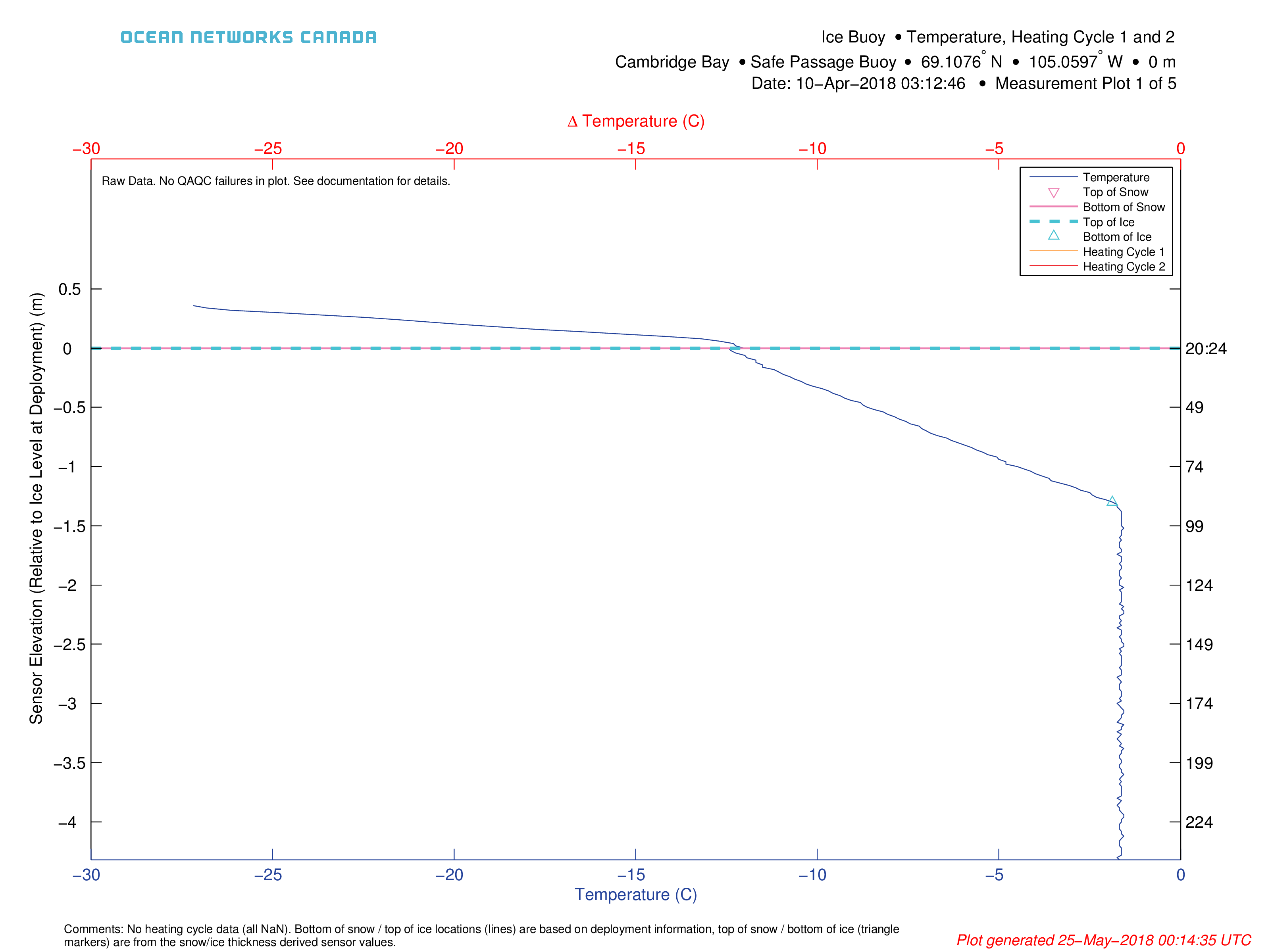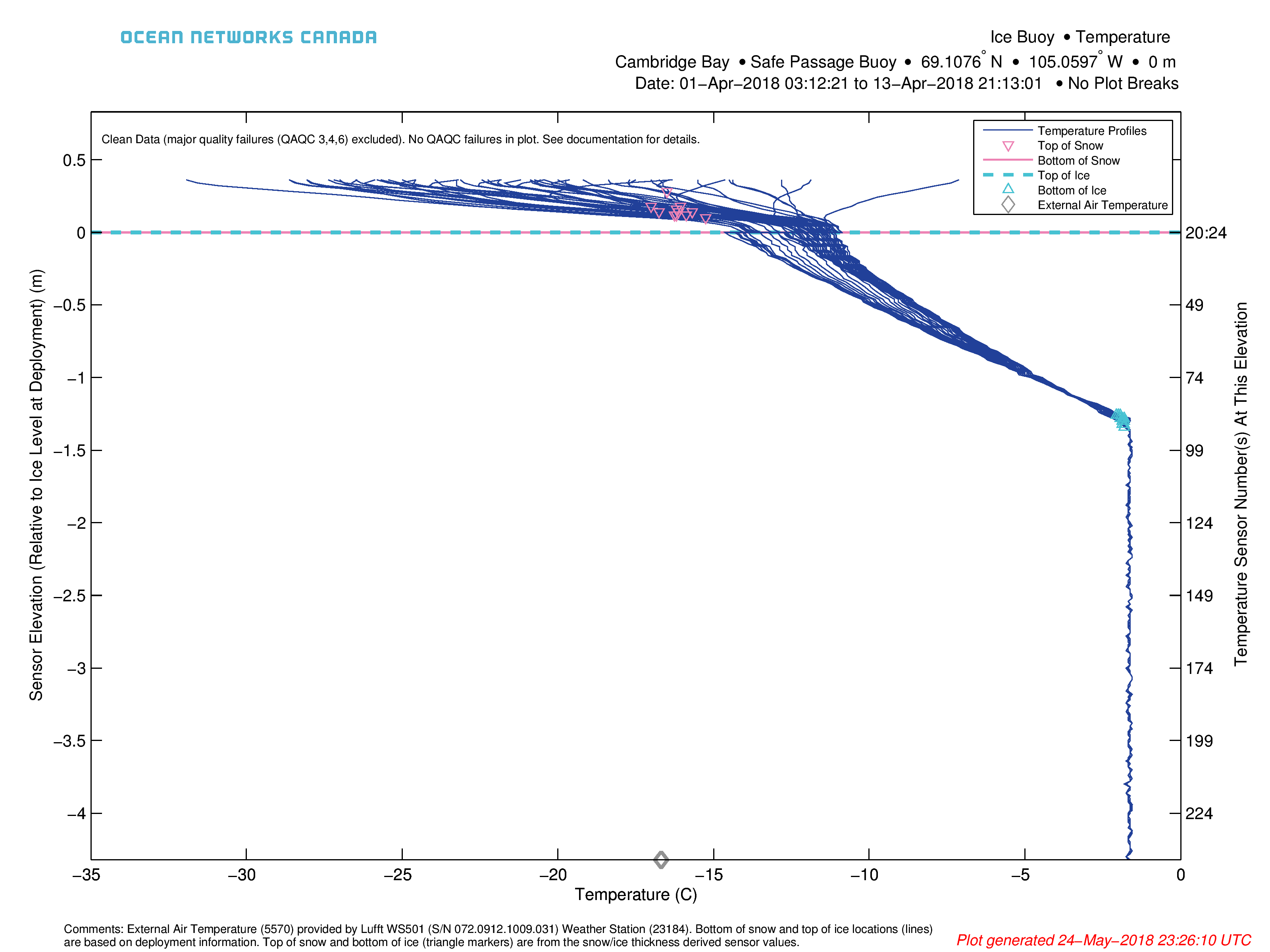Ice Buoy Profile Plots
The profile plots show temperature and heating cycle profiles This data product is specialized for the SRSL Ice Mass Balance Buoy . This type of device usually consists of 240 temperature sensors which also measure two sets of heating cycle temperature differentials; in all, the device has 3 groups of main sensors: temperature, heating cycle 1, heating cycle 2. The heating cycle sensors measure the change in temperature due to a small amount of heating periodically applied by the device. The sensor values are plotted against the sensor elevation, which is (SIMBA). SIMBA is simply a chain of temperature sensors (thermistors), string from a pole above and through and below the ice. There are normally 240 sensors spaced every 2 cm, and some may lay flat along the ice. The positioning of the sensors is documented in the device attributes for each deployment and device. The sensor elevation as plotted is normally set with zero being ice level at the time the sensors are deployed, however, ice can be generated on top of the sensors with melt and re-freeze events. By observing the temperature gradients, one can detect the ice and snow thickness, which we have automated as derived scalar sensors. The same physical 240 temperature sensors are also used in heating experiments where a small current is applied to heat the environment and observe the temperature change. In the deployment for 2016 near Cambridge BayOceans 2.0, the heating cycles (1 & 2) get their own sensors, so in all, this type of device has over 720 sensors. Currently, the temperature data has a sampling rate of 6 hours and each heating cycle has a sampling rate of 24 hours; this may change in other deployments. The data can be used to find ice and snow thickness. The air/snow interface can be identified based on the fact that a number of sensors located in the air have approximately the same temperature. Based on the same principle, the sensors located in water yield similar temperatures near the bottom of the ice. The snow/ice interface location can be estimated by investigating the temperature perturbations due to the sensor heating. In air, the heating cycles lead typically to a temperature rise of 2°C, in ice and water the typical value is about 0.2°C at least, Tellus A 2014, 66, 21564,Here is a good paper for reference: http://dx.doi.org/10.3402/tellusa.v66.21564.
Oceans 2.0 API filter: dataProductCode=IBPP
...
- 20170125: Initial Release
- 20180601: Major revision and made available to all
Data Product Options
| Include Page | ||||
|---|---|---|---|---|
|
...
This data is available as a PNG image or PDF file. See an example plot below (PNG format), note that this is poor quality test data.
Here is an example PDF: CambridgeBay_SafePassageBuoy_IceBuoy_20160429T000000Z_20160501T000000Z-Temperature-1-Temperature-736449.pdf.
a PNG or PDF.
Oceans 2.0 API filter: extension={png,pdf}
Unlike the ice buoy time series profile plots, separate plots are not created for the temperature and heating cycles. As specified in the options above, the one plot per measurement option includes the heating cycle data, whereas the daily and no breaks options only plot the temperatures. As shown below, this data product plots sensor elevation versus temperature, showing a profile of temperature or temperature change in the case of the heating cycle data. These plots are are suited for visualizing short time ranges, complimenting the long time ranges usable with the ice buoy time series profile plots. We recommend maximum 30 days for these plots. See examples below (click to enlarge.) These plots contain additional data such as the deployment metadata that is used to calculate the sensor elevation: the top of the ice and bottom of the snow sensors are both (normally) at elevation zero and the elevation decreases or increases (respectively) from them at the sensor spacing. See device attributes: iceBuoy_BottomOfSnow, iceBuoy_TopOfIce, iceBuoy_SensorSpacing. If this is not case, the sensor elevation plotted will be specified directly by the device attribute iceBuoy_sensorElevation. The locations of the top of snow, bottom of ice are also plotted, with the values coming from the scalar sensor values (these are derived sensors, contact us for information on the algorithm, internal documentation is here). An external air temperature sensor is often used to aid in the derivation of the snow thickness. Data are from it are also plotted.
Please note that these examples shown below are from incomplete test data.
Oceans 2.0 API filter: extension={png,pdf)
Discussion
To comment on this product, click Add Comment below.


